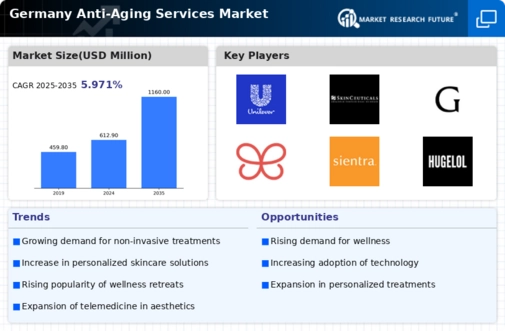Rising Disposable Income
The economic landscape in Germany, characterized by rising disposable incomes, is a significant driver for the anti aging-services market. As individuals experience an increase in their financial resources, they are more inclined to invest in personal care and wellness services. This trend is particularly evident among the middle and upper classes, who prioritize aesthetics and health. The anti aging-services market is expected to benefit from this economic growth, as consumers allocate a portion of their income towards anti aging treatments. In recent years, the average disposable income in Germany has seen a steady increase, which correlates with a heightened interest in premium anti aging services. This financial capability may lead to a broader acceptance of various treatments, thereby propelling the market forward.
Aging Population Dynamics
The demographic shift in Germany, characterized by an increasing aging population, plays a pivotal role in shaping the anti aging-services market. As life expectancy rises, the demand for services aimed at mitigating the effects of aging intensifies. By 2030, it is projected that over 25% of the German population will be aged 65 and older. This demographic trend indicates a growing market for anti aging-services, as older individuals seek to maintain their vitality and appearance. The anti aging-services market is likely to experience substantial growth, driven by the desire of this demographic to invest in their health and aesthetics. Furthermore, the increasing awareness of health and wellness among older adults may lead to a higher propensity to spend on anti aging solutions, thereby expanding the market further.
Cultural Shift Towards Youthfulness
In Germany, there is a notable cultural shift towards valuing youthfulness and vitality, which significantly impacts the anti aging-services market. This societal trend is reflected in the increasing acceptance of cosmetic procedures and wellness treatments aimed at enhancing appearance. The anti aging-services market is likely to thrive as more individuals embrace the idea of investing in their looks and overall well-being. This cultural inclination is further supported by media portrayals and celebrity endorsements that promote youthful aesthetics. As a result, the demand for anti aging services is expected to rise, with consumers actively seeking solutions that align with their desire to maintain a youthful appearance. This shift in cultural attitudes may also encourage innovation within the market, as providers strive to meet the evolving preferences of their clientele.
Technological Advancements in Treatments
The integration of advanced technologies in the anti aging-services market is transforming the landscape of available treatments in Germany. Innovations such as laser therapy, radiofrequency treatments, and advanced skincare formulations are becoming increasingly prevalent. These technologies not only enhance the efficacy of treatments but also improve safety and patient satisfaction. The anti aging-services market is witnessing a surge in demand for these high-tech solutions, as consumers become more informed about their options. In 2025, it is estimated that the market for non-invasive cosmetic procedures in Germany will reach approximately €1.5 billion, reflecting a growing preference for technology-driven solutions. This trend suggests that as technology continues to evolve, the anti aging-services market will likely expand, catering to a more discerning clientele seeking effective and innovative treatments.
Increased Awareness of Health and Wellness
The growing awareness of health and wellness among the German population is a crucial driver for the anti aging-services market. As individuals become more conscious of the impact of lifestyle choices on aging, there is a corresponding increase in demand for services that promote longevity and vitality. This trend is evident in the rising popularity of holistic approaches that combine skincare, nutrition, and fitness. The anti aging-services market is likely to benefit from this heightened awareness, as consumers seek comprehensive solutions that address both aesthetic and health concerns. In recent surveys, approximately 60% of respondents indicated a willingness to invest in anti aging services as part of their overall wellness strategy. This suggests a potential for growth in the market, as providers adapt their offerings to cater to the evolving needs of health-conscious consumers.




















Leave a Comment